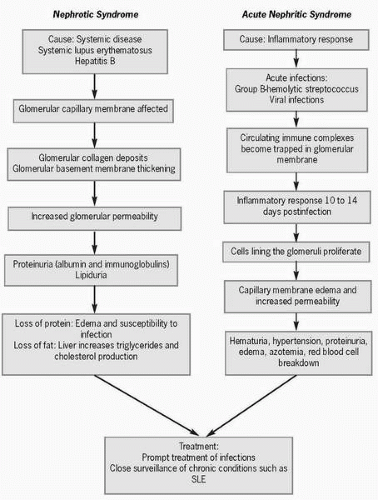Glomerulonephritis
Glomerulonephritis, classified as either nephritic syndrome or nephrotic syndrome, affects males more often than females and is the leading cause of chronic renal failure in the United States. Inflammatory injury to the glomeruli (nephritic syndrome) can occur as a result of antibodies interacting with normally occurring antigens in the glomeruli or as a result of antibody-antigen complexes that become lodged in the glomerular membrane (nephrotic syndrome). Chronic glomerulonephritis is the end stage of many types of glomerulonephritis, but it can also develop without a history of prior renal disease. In chronic glomerulonephritis, the kidneys are small and the glomeruli are sclerosed, leading to renal failure.
Pathophysiology
Nephrotic syndrome is caused by systemic diseases such as systemic lupus erythematosus and hepatitis B, as a reaction to gold therapy, and idiopathically. This syndrome affects the glomerular capillary membrane, leading to increased glomerular permeability, secondary to collagen deposits in glomeruli and thickening of the glomerular basement membrane. Proteinuria, including loss of albumin and immunoglobulins, equal to or exceeding 3.5 g/day; lipiduria (i.e., fat in the urine); low serum albumin; generalized edema due to low serum colloidal osmotic pressure; and hyperlipidemia are characteristics of nephrotic syndrome. Loss of immunoglobulins increases the chance of developing infections. As a compensatory reaction to proteinuria, the body increases albumin production and the liver increases triglycerides and cholesterol production. This puts a person with nephrotic syndrome at risk for atherosclerosis. Hypercoagulability with resultant venous clot formation, especially in the renal veins, is thought to occur because of the loss of clot-inhibiting factors from the urine.
 Glomerulonephritis is the leading cause of chronic renal failure in the United States.
Glomerulonephritis is the leading cause of chronic renal failure in the United States.Stay updated, free articles. Join our Telegram channel

Full access? Get Clinical Tree


Get Clinical Tree app for offline access


